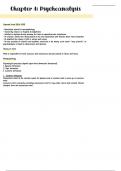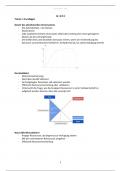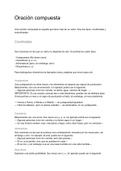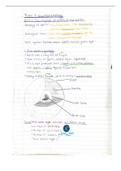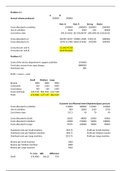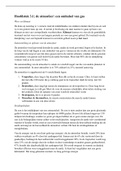"Polar
Bear
with
Salmon"
can't
get
through
membrane
via
simple
diffusion:
-‐
Water
(in
ice)
-‐
charged
molecules
(polar,
ions)
-‐
Protein
(big,
bear)
Gas
can
pass
freely.
Simple
(passive)
diffusion:
along
concentration
gradient,
no
energy;
gas
can
pass
Facilitated
(passive)
diffusion:
along
concentration
gradient,
no
energy,
need
carrier
protein/transporter
to
open
gate;
glucose,
AAs
(polar)
(Primary)
active
transport:
against
concentration
gradient,
need
energy
from
ATP
hydrolysis;
substrate
binds
carrier/transporter,
conformational
change,
open
gate;
ATPase/Na+/K+
pump
Secondary
active
transport:
against
concentration
gradient,
no
need
energy
from
ATP
hydrolysis,
use
electrochemical
gradient;
need
co-‐transport
(antiport/symport)
Polarization
inside
the
cell:
-‐
depolarize:
more
positive
-‐
hyperpolarize:
more
negative
Exocytosis:
-‐
kiss
&
run:
rapid,
low-‐rate
signaling;
vesicles
go
a
few
rounds
to
empty
stuff
inside
-‐
full:
slow,
high-‐rate
signaling,
complete
fusion,
balance
with
endocytosis
How
to
create
MP:
1.
need
a
concentration
gradient,
use
ATPase
or
other
enzyme
pumps
2.
semi-‐permeable
membrane
ions
then
diffuse
along
concentration
gradient
to
create
electrical
gradient
Membrane
channels
-‐
central
pores,
made
out
of
subunits,
pore
loops
on
membrane
-‐
selectivity
filter:
size
&
charges
-‐
conformational
change,
switch
between
open/close
-‐
ligand-‐gated:
e.g.
enzyme/hormone/neurotransmitter
binds,
then
open
the
gate
-‐
voltage-‐gated:
e.g.
S4
got
(+)
wings
get
pulled
down
by
(-‐),
closed
usually;
beyond
-‐50mV,
not
negative
enough,
S4
not
pulled
down,
gate
opens
up,
K+
gets
thru.
ATPase/Na+/K+
pump:
eat
up
one
ATP,
3
Na+
out,
2
K+
in
At
rest,
membrane
is
more
permeable
to
K+
than
to
Na+;
at
rest,
MP
=
-‐70mV
K+
leakage
channel:
always
some
K+
leaking
out,
wanting
MP
to
be
at
-‐90mV;
main
factor
of
restoring
MP
below
-‐55mV
so
Na+
voltage
gated
channel’s
inactivation
gate
can
drop
back
down
K+
voltage
gated
channel:
-‐70mV
~
+30mV
closed;
after
+30mV
opens
up
and
after-‐hyperpolarization,
small
dip
on
MP
due
to
delay
opening,
can
go
down
to
-‐80mV
Na+
voltage-‐gated
channel:
-‐
Na+
voltage-‐gated
channels
usually
close;
activation
gate
closes
at
-‐70mV
-‐
need
depolarization
(more
+
above
-‐50mV)
to
open
up,
for
S4
wings
not
get
pulled
down
too
much
-‐
threshold
potential
is
-‐55mV
for
Na+
voltage-‐gated
channels
to
start
opening
up,
loosening
up
activation
gate,
then
at
-‐50mV
they’re
completely
open;
at
-‐55mV
an
AP
is
fired
-‐
inactivation
gate
swings
shuts
at
+30mV
, -‐
MP
has
to
fall
below
-‐55mV
threshold
again
for
inactivation
gate
to
swing
back
down
(reconfigure
Na+
voltage
gated
channels)
Nerst
equation:
about
one
type
of
ion
only
Goldman
equation:
about
multiple
types
of
ions
-‐
K+
wants
MP
to
sit
at
-‐90mV
-‐
Na+
wants
MP
to
sit
at
+60mV
-‐
Cl-‐
wants
MP
to
sit
at
-‐70mV
-‐
after
battle,
at
rest
it’s
-‐70mV,
after
using
Goldman
For
Na+:
-‐
pre-‐existing
chemical
concentration
gradient
never
changes
because
of
the
set
semi-‐permeability:
Na+
always
want
to
go
in
(influx:
chemical
force
always
direct
inward
for
Na+).
-‐
Need
to
use
pump
if
going
the
opposite
way.
For
Cl-‐:
-‐
big
anion
proteins
stuck
inside
the
cell,
with
(-‐)
charges
-‐
pushing
Cl-‐
outward
-‐
not
because
of
pump
For
K+:
-‐
most
permeable
ion
to
membrane
-‐
leaking
out
through
leakage
channels,
wants
MP
to
drop
from
-‐70mV
to
-‐90mV;
pre-‐set
chemical
force
pointing
outward
-‐
pumped
in
through
pump
-‐
injecting
tons
of
K+
outside
of
membrane
kills
the
pre-‐existing
outward
chemical
force
(chemical
concentration
gradient),
e.g.
death
penalty
Action
potential:
-‐
need
lots
of
Na+
voltage
gated
channels,
i.e.
excitable
-‐
threshold
-‐55mV
“all
or
none”:
threshold
stimulus
&
suprathreshold
stimulus
gives
the
same
magnitude
of
AP
-‐
frequency
coding:
more
frequent
APs
fired,
more
intense
-‐
steps
(K+
leakage
channels
are
always
there):
1.
resting
MP
-‐70mV
2.
somehow
depolarize
membrane,
more
(+);
at
-‐55mV
threshold
potential,
AP
is
fired;
3.
MP
goes
up
to
-‐50mV;
Na+
voltage
gated
channel
starts
to
open
up
4.
Na+
enters,
depolarize,
more
opening
Na+
channels,
reaching
+55mV,
AP
fired
5.
Na+
closes
at
+30mV;
K+
voltage
gated
channels
begin
opening
(both
chemical
and
electrical
forces
pointing
outward
for
K+
at
+30mV)
6.
K+
rushes
out
7.
after-‐hyperpolarization
8.
K+
voltage
gated
channels
close
9.
returns
to
resting
MP
-‐70mV
-‐70mV
~
-‐55mV:
at
-‐55mV,
AP
fired;
both
Na+
&
K+
channels
closed
-‐55mV
~
-‐50mV:
at
-‐50mV,
Na+
open;
K+
closed
-‐50mV
~
+30mV:
at
30mV,
Na+
closed;
K+
open
+30
~
-‐70mV:
K+
remain
open
-‐70mV
~
80mV
~70mV:
Na+
starts
to
reset;
K+
starts
to
close
Bear
with
Salmon"
can't
get
through
membrane
via
simple
diffusion:
-‐
Water
(in
ice)
-‐
charged
molecules
(polar,
ions)
-‐
Protein
(big,
bear)
Gas
can
pass
freely.
Simple
(passive)
diffusion:
along
concentration
gradient,
no
energy;
gas
can
pass
Facilitated
(passive)
diffusion:
along
concentration
gradient,
no
energy,
need
carrier
protein/transporter
to
open
gate;
glucose,
AAs
(polar)
(Primary)
active
transport:
against
concentration
gradient,
need
energy
from
ATP
hydrolysis;
substrate
binds
carrier/transporter,
conformational
change,
open
gate;
ATPase/Na+/K+
pump
Secondary
active
transport:
against
concentration
gradient,
no
need
energy
from
ATP
hydrolysis,
use
electrochemical
gradient;
need
co-‐transport
(antiport/symport)
Polarization
inside
the
cell:
-‐
depolarize:
more
positive
-‐
hyperpolarize:
more
negative
Exocytosis:
-‐
kiss
&
run:
rapid,
low-‐rate
signaling;
vesicles
go
a
few
rounds
to
empty
stuff
inside
-‐
full:
slow,
high-‐rate
signaling,
complete
fusion,
balance
with
endocytosis
How
to
create
MP:
1.
need
a
concentration
gradient,
use
ATPase
or
other
enzyme
pumps
2.
semi-‐permeable
membrane
ions
then
diffuse
along
concentration
gradient
to
create
electrical
gradient
Membrane
channels
-‐
central
pores,
made
out
of
subunits,
pore
loops
on
membrane
-‐
selectivity
filter:
size
&
charges
-‐
conformational
change,
switch
between
open/close
-‐
ligand-‐gated:
e.g.
enzyme/hormone/neurotransmitter
binds,
then
open
the
gate
-‐
voltage-‐gated:
e.g.
S4
got
(+)
wings
get
pulled
down
by
(-‐),
closed
usually;
beyond
-‐50mV,
not
negative
enough,
S4
not
pulled
down,
gate
opens
up,
K+
gets
thru.
ATPase/Na+/K+
pump:
eat
up
one
ATP,
3
Na+
out,
2
K+
in
At
rest,
membrane
is
more
permeable
to
K+
than
to
Na+;
at
rest,
MP
=
-‐70mV
K+
leakage
channel:
always
some
K+
leaking
out,
wanting
MP
to
be
at
-‐90mV;
main
factor
of
restoring
MP
below
-‐55mV
so
Na+
voltage
gated
channel’s
inactivation
gate
can
drop
back
down
K+
voltage
gated
channel:
-‐70mV
~
+30mV
closed;
after
+30mV
opens
up
and
after-‐hyperpolarization,
small
dip
on
MP
due
to
delay
opening,
can
go
down
to
-‐80mV
Na+
voltage-‐gated
channel:
-‐
Na+
voltage-‐gated
channels
usually
close;
activation
gate
closes
at
-‐70mV
-‐
need
depolarization
(more
+
above
-‐50mV)
to
open
up,
for
S4
wings
not
get
pulled
down
too
much
-‐
threshold
potential
is
-‐55mV
for
Na+
voltage-‐gated
channels
to
start
opening
up,
loosening
up
activation
gate,
then
at
-‐50mV
they’re
completely
open;
at
-‐55mV
an
AP
is
fired
-‐
inactivation
gate
swings
shuts
at
+30mV
, -‐
MP
has
to
fall
below
-‐55mV
threshold
again
for
inactivation
gate
to
swing
back
down
(reconfigure
Na+
voltage
gated
channels)
Nerst
equation:
about
one
type
of
ion
only
Goldman
equation:
about
multiple
types
of
ions
-‐
K+
wants
MP
to
sit
at
-‐90mV
-‐
Na+
wants
MP
to
sit
at
+60mV
-‐
Cl-‐
wants
MP
to
sit
at
-‐70mV
-‐
after
battle,
at
rest
it’s
-‐70mV,
after
using
Goldman
For
Na+:
-‐
pre-‐existing
chemical
concentration
gradient
never
changes
because
of
the
set
semi-‐permeability:
Na+
always
want
to
go
in
(influx:
chemical
force
always
direct
inward
for
Na+).
-‐
Need
to
use
pump
if
going
the
opposite
way.
For
Cl-‐:
-‐
big
anion
proteins
stuck
inside
the
cell,
with
(-‐)
charges
-‐
pushing
Cl-‐
outward
-‐
not
because
of
pump
For
K+:
-‐
most
permeable
ion
to
membrane
-‐
leaking
out
through
leakage
channels,
wants
MP
to
drop
from
-‐70mV
to
-‐90mV;
pre-‐set
chemical
force
pointing
outward
-‐
pumped
in
through
pump
-‐
injecting
tons
of
K+
outside
of
membrane
kills
the
pre-‐existing
outward
chemical
force
(chemical
concentration
gradient),
e.g.
death
penalty
Action
potential:
-‐
need
lots
of
Na+
voltage
gated
channels,
i.e.
excitable
-‐
threshold
-‐55mV
“all
or
none”:
threshold
stimulus
&
suprathreshold
stimulus
gives
the
same
magnitude
of
AP
-‐
frequency
coding:
more
frequent
APs
fired,
more
intense
-‐
steps
(K+
leakage
channels
are
always
there):
1.
resting
MP
-‐70mV
2.
somehow
depolarize
membrane,
more
(+);
at
-‐55mV
threshold
potential,
AP
is
fired;
3.
MP
goes
up
to
-‐50mV;
Na+
voltage
gated
channel
starts
to
open
up
4.
Na+
enters,
depolarize,
more
opening
Na+
channels,
reaching
+55mV,
AP
fired
5.
Na+
closes
at
+30mV;
K+
voltage
gated
channels
begin
opening
(both
chemical
and
electrical
forces
pointing
outward
for
K+
at
+30mV)
6.
K+
rushes
out
7.
after-‐hyperpolarization
8.
K+
voltage
gated
channels
close
9.
returns
to
resting
MP
-‐70mV
-‐70mV
~
-‐55mV:
at
-‐55mV,
AP
fired;
both
Na+
&
K+
channels
closed
-‐55mV
~
-‐50mV:
at
-‐50mV,
Na+
open;
K+
closed
-‐50mV
~
+30mV:
at
30mV,
Na+
closed;
K+
open
+30
~
-‐70mV:
K+
remain
open
-‐70mV
~
80mV
~70mV:
Na+
starts
to
reset;
K+
starts
to
close


